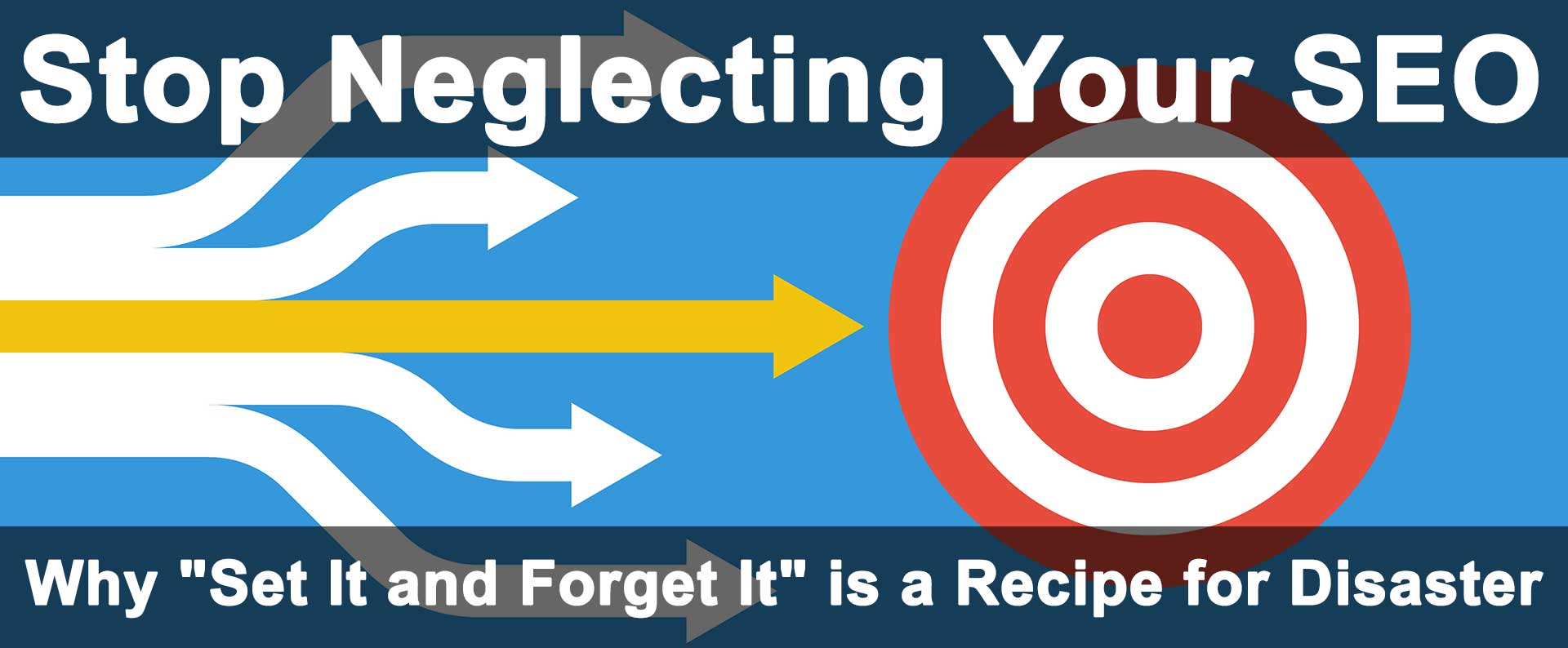A strong online presence is no longer a luxury, it's a necessity. And at the heart of that online presence lies Search Engine Optimization (SEO). One of the biggest misconceptions about SEO is that it's a one-time fix.
The truth is, SEO is a continuous process, requiring ongoing attention and refinement. Thinking you can "set it and forget it" is a recipe for disaster.
Why SEO Isn't "Set It and Forget It"
SEO (Search Engine Optimization) is the process of improving your website’s visibility on search engines like Google. However, unlike a brochure or billboard, your website exists in a dynamic environment:
- Algorithm Updates:
Google updates its algorithm 500–600 times yearly, requiring adjustments to stay visible.
- Competitor Activity:
Rivals may outpace you with fresh content or better technical SEO.
- User Expectations:
Customers demand faster load times, mobile-friendly designs, and up-to-date information.
- Content Decay:
Old blog posts or pages lose relevance without updates.
Key Components of Ongoing SEO:
Regularly monitor the following key factors important for SEO:
- Keyword Research:
Continually refine the keywords you target based on emerging trends.
- Content Updates:
Regularly produce fresh content that resonates with your audience (blogs, service pages).
- Analytics Monitoring:
Use tools like Google Analytics to track performance, assess user behavior, and adjust strategies accordingly.
- Link Building:
Build new backlinks to enhance domain authority and visibility over time.
- Technical SEO Audits:
Schedule periodic audits of your site to address speed, mobile responsiveness, and technical errors that could hinder rankings.
- Local SEO:
Optimize and refinement local SEO factors (Google My Business, reviews).
How Neglecting SEO Impacts Your Business
Businesses that treat SEO as a one-time task risk potentially serious consequences, such as decreased site traffic and lower conversion rates. Ignoring ongoing SEO can lead to:
- Decreased Visibility:
As algorithms change and competitors optimize, your website can slip down search engine rankings, making it harder for potential customers to find you.
- Loss of Traffic:
Lower rankings mean less organic traffic, resulting in fewer leads and ultimately, fewer sales.
- Damage to Credibility:
Outdated content and broken links can make your business appear unprofessional and untrustworthy.
- Missed Opportunities:
New keywords and search trends emerge constantly. Without regular SEO updates, you miss out on capitalizing on these opportunities.
- Increased Ad Spend:
Professional service firms that lose organic visibility may rely more on costly paid ads to compensate.
Actionable Steps:
- Conduct monthly keyword audits to identify new relevant terms.
- Regularly update your content to reflect seasonal offerings or promotions.
- Monitor competitor keywords with tools like SEMrush.
- Update meta descriptions and headers to reflect trends.
How Neglecting SEO Impacts Customer Experience
Customer experience is closely tied to SEO. An optimized site enhances usability, making it easier for potential customers to find the information they need. Conversely, stagnant SEO can harm customer interaction:
- Poor User Experience:
Outdated website design, slow loading times, and broken links frustrate users and drive them away.
- Irrelevant Content:
If your content doesn't address current customer needs and searches, they won't find it valuable, leading to higher bounce rates.
- Difficulty Finding Information:
Poor site architecture and lack of optimized content makes it hard for customers to find what they’re looking for.
Actionable Steps:
- Implement mobile optimization to ensure your site functions seamlessly on all devices.
- Fix broken links and improve page speed (use Google PageSpeed Insights) by compressing images and leveraging browser caching.
- Add structured data (schema markup) for FAQs and services.
- Optimize for voice search with natural-language phrases (e.g., “How do I file a small business tax extension?”).
Benefits of Ongoing SEO Focus
A well-executed SEO strategy enhances the overall experience for your customers. Here's how:
1. Improved Navigation:
- A company’s website that is regularly updated is easy for potential customers to navigate, helping them quickly find information on services, testimonials, and contact details.
2. Relevant Content:
- By frequently publishing blog posts or articles relevant to customer interests, you engage visitors, establishing your authority and encouraging them to return.
3. Load Speed & Mobile Optimization:
- A mobile-friendly site that loads quickly keeps users engaged, reducing bounce rates and increasing the likelihood of conversions.
By committing to regularly improving SEO strategies, businesses across various industries can reap significant rewards:
- Retail:
Online boutiques can implement seasonal keyword changes and offer promotions, keeping their website fresh and relevant to shoppers seeking the latest fashion trends.
- Restaurants:
Creating consistent blog content about food trends and sustainable practices can engage customers and strengthen local SEO.
- Hospitality:
Hotels can update their SEO-focused landing pages to reflect current travel deals, attracting more bookings.
- Construction:
By publishing case studies and project highlights, construction firms can maintain a robust online presence, showcasing their expertise and drawing in prospective clients.
- Healthcare:
Regularly updating service pages with new research and guidelines can keep healthcare providers competitive, enhance patient trust, and improve search visibility.
- Professional Services:
Law firms can write articles addressing current legal issues, positioning themselves as thought leaders and improving search rankings.
Actionable SEO Steps by Industry
Use these steps as ongoing tasks (weekly, monthly, quarterly) rather than one-time fixes:
1. Retail:
- Weekly:
Update product availability, schema product markup (price, availability), and image alt text.
- Monthly:
Refresh top-selling product descriptions with keywords based on search trends; run site search reports.
- Quarterly:
Audit site speed, mobile checkout flow, and canonical tags; address duplicate content.
- Local:
Keep Google Business Profile hours and promotions current; solicit and respond to reviews.
2. Restaurants:
- Weekly:
Update menu pages, daily specials, and schema for menus and reservations.
- Monthly:
Monitor and respond to Google/Yelp/TripAdvisor reviews; add photos and posts.
- Quarterly:
Audit local listings for accuracy; test mobile ordering and page speed.
- Content:
Publish seasonal blog posts (events, pairings, menu changes) and optimize for “near me” queries.
3. Hospitality:
- Weekly:
Confirm booking widget works across devices; update availability and rates.
- Monthly:
Keep structured data for hotels up to date (reviews, pricing); optimize landing pages for events/seasonal search.
- Quarterly:
Review backlinks and local citations; optimize images for load time.
- Content:
Create localized guides (top attractions, transportation) to capture travel-intent queries.
4. Construction:
- Weekly:
Publish recent project photos and update portfolio pages with location-specific keywords.
- Monthly:
Add or refresh service pages (e.g., “kitchen remodel [city]”), optimize for local intent.
- Quarterly:
Verify business licensing/insurance details on-site and on local directories; audit backlink quality.
- Content:
Post case studies and before/after galleries with clear CTAs for quotes.
5. Healthcare:
- Weekly:
Ensure provider profiles (bios, specialties, credentials) are accurate and schema-marked.
- Monthly:
Monitor and reply to reviews and online questions; update appointment availability and telehealth info.
- Quarterly:
Check for compliance with privacy and accessibility standards; run site speed and mobile usability tests.
- Content:
Publish FAQs and condition-specific guides that answer patient queries and include local keywords.
6. Professional Services (Legal, Accounting, etc.):
- Weekly:
Keep service offerings and attorney/accountant bios current; add client-focused FAQs.
- Monthly:
Publish thought leadership or compliance updates targeting high-value queries (e.g., “small business tax credits [year]”).
- Quarterly:
Audit content for industry changes and case studies; build targeted local landing pages for practice areas.
- Local:
Manage citations in directories, collect reviews, and ensure NAP (name, address, phone) consistency.
Actionable Steps for All Industries
- Develop a Content Calendar:
Plan regular updates for blogs, service pages, and newsletters.
- Keyword Research & Analysis:
Identify the most relevant keywords your target audience is using.
- Solicit Customer Feedback:
Utilize surveys or reviews to gather insights about services that may need improvement or updates on your website.
- On-Page Optimization:
Optimize your website’s content, structure, and meta descriptions.
- Off-Page Optimization:
Build high-quality backlinks to improve your website's authority.
- Local SEO:
Optimize your Google My Business profile and local directory listings.
- SEO Audits & Reporting:
Track your SEO performance and provide regular reports.
- Build Relationships:
Collaborate with local influencers or other businesses to enhance backlinks and visibility.
Final Takeaway: Stay Ahead with Continuous SEO
Treat SEO as an ongoing investment, not a one-time fix. SEO is a continuous commitment that supports long-term business success, improves customer experience, and an investment in your brand’s digital longevity.
By treating it as an evolving strategy, small businesses can:
- Outrank larger competitors
- Improve customer trust through fresh, relevant content
- Adapt quickly to market shifts
By actively engaging in ongoing SEO practices, businesses can stay ahead of the competition and ensure they meet their customers' evolving needs. Don't let your SEO become a liability, develop and implement a sustainable SEO strategy that drives results.













